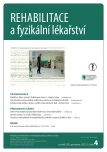Effect of dynamic neuromuscular stabilization in patients after arthroscopy of the shoulder joint
Authors:
Martinásková N. 1; Hagovská M. 2; Vaská E. 3
Authors‘ workplace:
Klinika liečebnej rehabilitácie, Lekárska Fakulta UPJŠ v Košiciach, Nemocnica Agel, Košice-Šaca, Slovenská republika
1; Klinika fyziatrie, balneológie a liečebnej rehabilitácie, Lekárska Fakulta UPJŠ v Košiciach, Slovenská republika
2; Katedra Fyzioterapie, Fakulta zdravotníckych vied Univerzity sv. Cyrila a Metoda v Trnave, Slovenská republika
3
Published in:
Rehabil. fyz. Lék., 28, 2021, No. 4, pp. 158-164.
Category:
Original Papers
doi:
https://doi.org/10.48095/ccrhfl2021158
Overview
Aim: The aim of the work was to compare the effect of dynamic neuromuscular stabilization (DNS) in the experimental group in comparison with classical rehabilitation in the control group in patients after arthroscopic shoulder surgery. The effect of the treatment and its influence on pain, disability, range of motion of the shoulder joint, as well as the quality of life of patients after surgery were evaluated. Sample and methods: The research sample consisted of 73 patients after arthroscopic shoulder surgery (with a mean age of 46.88 ± 13.74 years). They were randomly divided into two groups - experimental (n = 36) and control (n = 37). Intervention: The intervention lasted 2 weeks for both groups. Experimental group – DNS 5 times a week for 30 minutes, control group – classic rehabilitation 5 times a week for 30 minutes. The DASH – Shoulder Disability Questionnaire was used to assess shoulder pain and disability. Quality of life was assessed by the SF-36 questionnaire, which assesses the perception of health status and consists of eight subscales for physical and mental components. This questionnaire is suitable for assessing the quality of life in patients with chronic pain. It contains the following sections: physical functioning, limitations in roles due to physical difficulties, physical pain, perception of general health, vitality, social functioning, limitations in roles due to mental difficulties, mental health, total score. Results: In the assessment of pain and disability after treatment, there were significant differences between the groups – p ≤ 0.05 – in the overall score of the DASH questionnaire in favour of the experimental group. In the evaluation of quality of life using the S-36 (The Short Form Health Survey 36 items) questionnaire, significant differences – p ≤ 0.05 – were noted after treatment between groups in the domains: limitations in roles due to physical difficulties, physical pain, social functioning in favour of the experimental group. In the other quality of life domains, no significant differences were observed between the two groups after treatment. Conclusion: DNS has been shown to be a suitable and complex method for reducing disability and shoulder pain in patients after arthroscopy, but it is necessary to practice this method for a longer period of time to improve muscle stability and strength.
Keywords:
disability – Pain – Quality of life – words: dynamic neuromuscular stabilization – classical rehabilitation – arthroscopy of the shoulder joint
Sources
- Přikryl P, Sadovský P et al. Artroskopie ramene. Praha: Galén 2007. ISBN 978-80-7262-508-6.
- Paavola M, Malmivaara A, Taimela S et al. Finnish Subacromial Impingement Arthroscopy Controlled Trial (FIMPACT): a protocol for a randomised trial comparing arthroscopic subacromial decompression and diagnostic arthroscopy (placebo control), with an exercise therapy control, in the treatment of shoulder impingement syndrome. BMJ Open 2017; 7(5): e014087. doi: 10.1136/bmjopen-2016-014087.
- Dylevský I. Speciální kineziologie. 1. vyd. Praha: Grada 2009. ISBN 978-80-247-1648-0.
- Kolář P. Vertebrogenní obtíže a stabilizační funkce svalů – diagnostika. Rehabil Fyz Lék 2006; 13(4): 155–169.
- Kolář P, Máček M et al. Základy klinické rehabilitace. 1. vyd. Praha: Galén 2015. ISBN 978-80-7492-219-0.
- Vaňásková E. Testování v neurorehabilitaci. Neurol Pro Praxi 2005; 6 : 311–314.
- Kolář P et al. Rehabilitace v klinické praxi. 1. vyd. Praha: Galén 2009. ISBN: 978-80-7262-657-1.
- Frank C, Kobesová A, Kolář P. Dynamic neuromuscular stabilization & sports rehabilitation. Int J Sports Phys Ther 2013; 8(1): 62–73.
- Kolář P. Vertebrogenní obtíže a stabilizační funkce páteře – terapie. Rehabil Fyz Lék 2007; 14(1): 3–17.
- Beaton DE, Katz JN, Fossel AH et al. Measuring the whole or the parts? Validity, reliability, and responsiveness of the Disabilities of the Arm, Shoulder and Hand outcome measure in different regions of the upper extremity. J Hand Ther 2001; 14(2): 128–146.
- Ware Jr. JE, Sherbourne CD. The MOS 36-item short-form health survey (SF-36) I. Conceptual framework and item selection. Medical Care 1992; 30(6): 473–483.
- Davidek P, Andel R, Kobesova A. Influence of dynamic neuromuscular stabilization approach on maximum kayak paddling force. J Hum Kinet 2018; 61 : 15–27. doi: 10.1515/hukin-2017-0127.
- Shim J, Park M, Lee S et al. The effects of shoulder stabilization exercise and shoulder isometric resistance exercise on shoulder stability and hand function. J Phys Ther Sci 2010; 22(3): 227–232. doi: 10.1589/JPTS.22.227.
- Kobesova A, Dzvonik J, Kolar P et al. Effects of shoulder girdle dynamic stabilization exercise on hand muscle strength. Isokinetics Exercise Sci 2015; 23(1): 21–32. doi: 10.3233/IES-140560.
- Kobesova A, Davidek P, Morris CE et al. Functional postural-stabilization tests according to Dynamic Neuromuscular Stabilization approach: proposal of novel examination protocol. J Bodyw Mov Ther 2020; 24(3): 84–95. doi: 10.1016/j.jbmt.2020.01.009.
Labels
Physiotherapist, university degree Rehabilitation Sports medicineArticle was published in
Rehabilitation & Physical Medicine

2021 Issue 4
Most read in this issue
- Gait rehabilitation in Parkinson’s disease patients – Cueing therapy
- Effect of dynamic neuromuscular stabilization in patients after arthroscopy of the shoulder joint
- Influencing the range of motion using trigger point therapy – systematic review
- Update of the Czech translation of the International Classification of Functioning, Disability and Health
